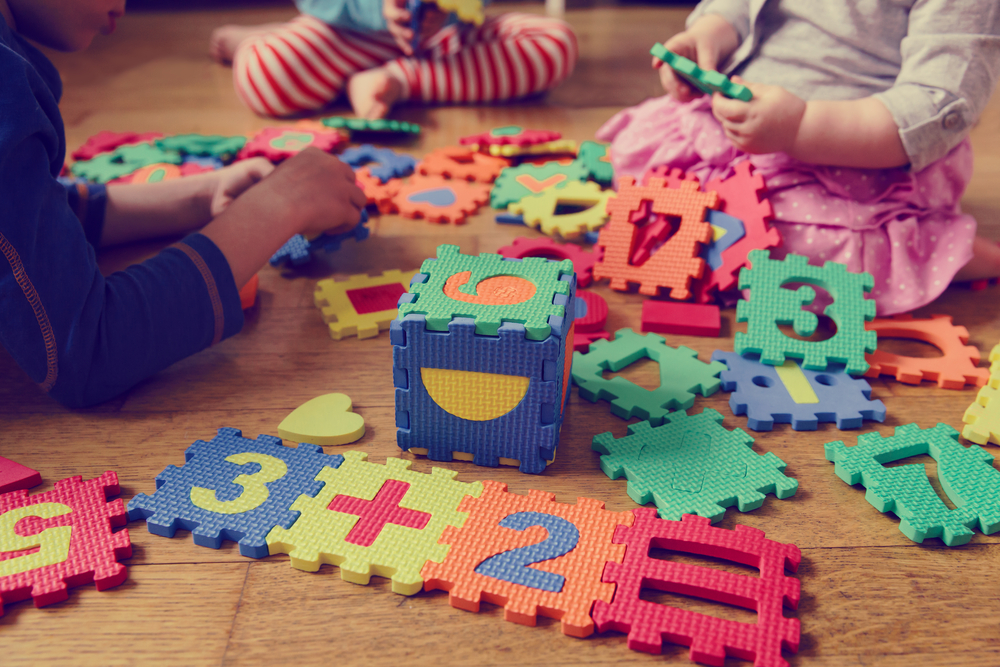In the age of technology, it’s no secret that children’s play habits have undergone a radical transformation. Screens often steal the spotlight, luring young minds into the captivating realm of online video games, instead of the beneficial games crucial for their mental and physical well-being.
Since it is impossible to completely isolate children from technology, it is important to balance screen time with other forms of play that encourage physical movement and social interaction and stimulate the mind and creativity.
While outdoor activities provide countless benefits, sometimes weather conditions or other restrictions require other alternatives at home. Therefore, this article unveils a treasure trove of homegrown entertainment, which vary between movement games, mind-stimulating games, and creativity development games.
So, if you’re concerned about your child’s screen time, these games will provide them with a wealth of opportunities to learn, explore, and most importantly, have fun!
Firstly: Physical Games
1. Indoor Bowling

This game is a great one to reuse empty water bottles – or you can also buy an indoor bowling set from a toy store. Place 6 to 10 water bottles ,or bowling pins, at the end of the living room or wherever there is space in the house. If you need to secure water bottles or make the game more difficult, fill them with some water.
Create a start line using a tape, and use some cardboard boxes as bumpers. After that, all you have to do is get a medium-sized plastic ball and start bowling!
This game guarantees that your children will have physical activity in their play routine, which is important for strengthening their physical fitness, as we explained in our article about the importance of play for children. Again, if you want the playing experience to be more realistic, you can buy an inexpensive complete bowling set from a children’s toy store.
2. Indoor Basketball

Another game added to our list of physical games is indoor basketball. This game is a fun and sporty way for kids to enjoy basketball while at home, which is a great option for days when outdoor play is not possible.
All you need is a bucket and a plastic ball. Each child takes a turn throwing the ball into the bucket. You can either place the bucket on the floor or hang it high on the wall. When a child scores a goal, they take a step back and shoot again until they miss. In the end, the player who shoots the ball into the bucket from the furthest distance is the winner.
Of course, if you want, you can buy a complete basketball set from a toy store, which includes the ball, the basket, and the stand that attaches the basket to the wall.
3. Balloon Volleyball
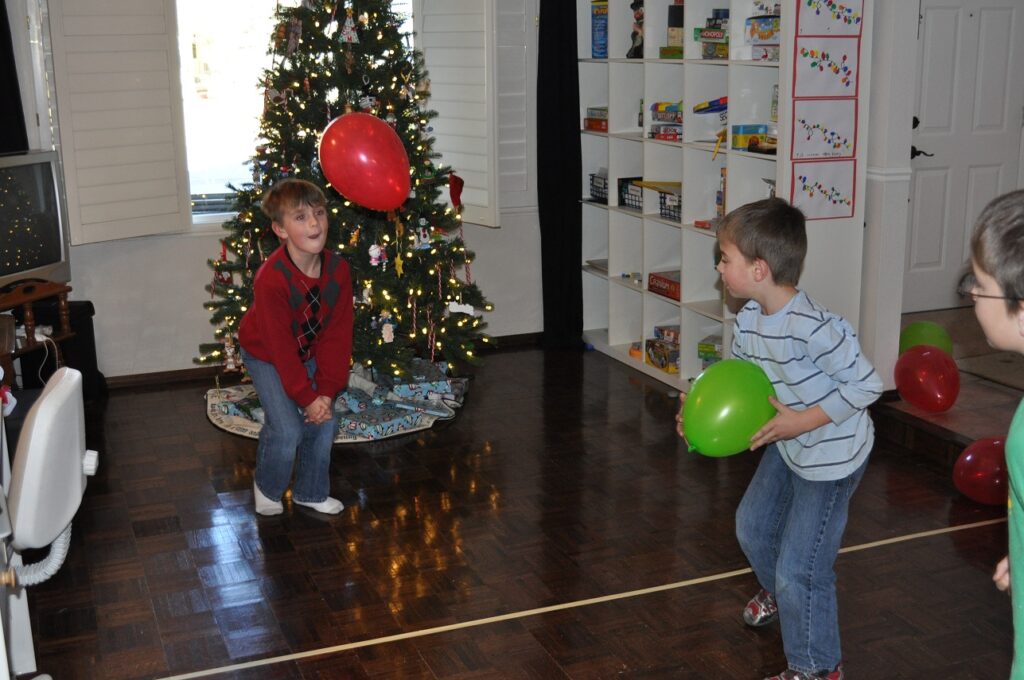
Balloon volleyball will be the perfect game for your children if they love playing with balloons. All you need is a balloon, and let the kids keep blowing it quietly so it stays in the air for the longest time. After that, players take turns to hit the balloon, and if one of them lets the balloon fall to the ground, they lose the game.
This game will certainly improve children’s motor skills as they make many movements while running around the balloon. It also will improve hand-eye coordination as children have to watch the balloon descend and then throw it back into the air.
4. Hopscotch

Hopscotch is a traditional and fun game based on movement and physical activity. Children begin by drawing rectangles on the ground and then drawing numbers inside them from 1 to 8. Then each child takes a turn to throw a small stone into a box and then go to take it back. Jumping and balancing on one foot while crossing the hopscotch rectangles helps children develop motor skills and gain more balance and physical strength.
Typically, hopscotch is played outside. However, you can have your kids play hopscotch at home too. You can simply form the rectangles using colored tape on the floor, or cut cardboard into large square or rectangular pieces, write numbers one through eight on them, and stick them to the floor with tape. Now, give the kids a small object to throw and let them enjoy the game.
Secondly: Brain Stimulation Games
5. Puzzles

Puzzle games are considered one of the classics in the world of children’s games. Through puzzle games, you can enhance your child’s creativity, cognitive functions and problem-solving skills taking into consideration the difficulty level convenient to your child’s age.
Puzzles can also be a social activity, as they teach children how to cooperate while working together toward a common goal. It’s a game that grows with the child, offering more complex challenges as their skills progress.
Therefore, incorporating puzzle games into your child’s daily play routine can lead to great mental development, making it one of the best indoor games for kids.
6. Rubik’s cube

The goal of this game is to mix the small cubes of different colors by rotating the individual layers of the cube and then returning it to its original shape, where each face of the cube displays one color.
The special thing about Rubik’s Cube is that it is not just a puzzle to rearrange colors, but rather a tool to enhance your child’s brain functions. When a child twists and turns the cube to align the colors, they challenge their mind by developing effective strategies to solve the puzzle and thus enhance their problem-solving skills.
In addition, the cube improves memory and concentration, as children learn to anticipate and remember the movement sequences. Consequently, including a Rubik’s Cube among your child’s toys can greatly improve their cognitive skills.
7. Card games
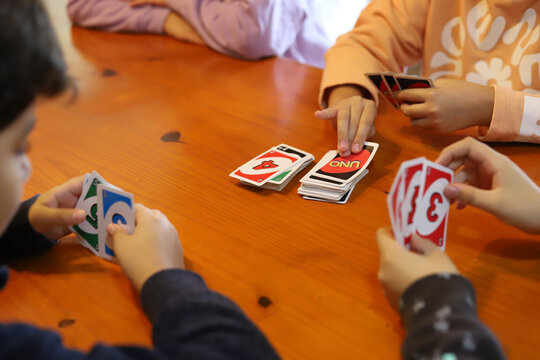
Besides the entertainment card games provide, they can also give many benefits to your child’s brain. Since many card games involve counting, addition, subtraction and thinking, they can help children develop their math skills in a fun and engaging way. For example, games like “War,” “Go Fish,” and “Uno” involve learning about basic arithmetic and numerical operations.
Additionally, memory-based card games challenge children to remember the location of cards and match pairs, improving their memory and concentration abilities. You can simply arrange a set of cards randomly and give the child time to remember the location of each card, then turn all the cards over and make them locate each number using their memory.
8. Touch-and-Feel Box
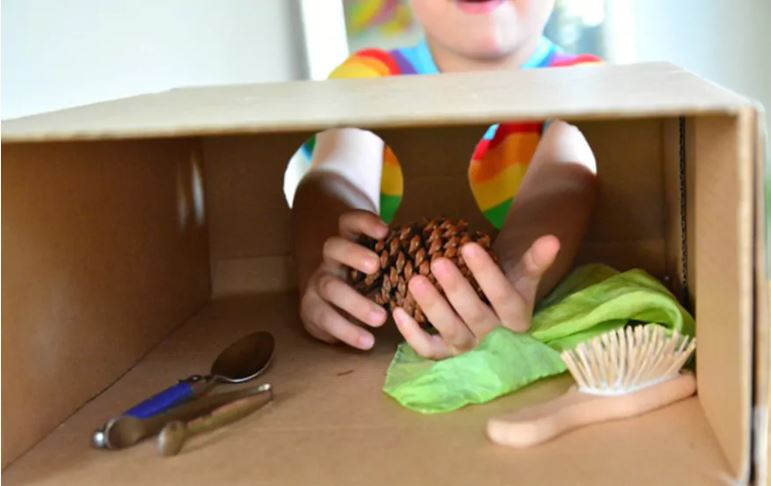
This game involves placing different objects inside a box, so that children can touch them without seeing them, and then try to guess what the object inside the box is based on its texture and external structure.
Find any box in your home, and make a hole in one side of the box and make sure it is large enough for your child to put their hand in. Next, collect a variety of objects with different textures. For example, you can place objects such as stones, a piece of soft cloth, a rubber ball, a piece of sandpaper, a sponge, or anything else you have on hand.
When you’re ready to play, place an object inside the box and ask your children to guess it. They can ask questions about it if they need to, or you can provide some hints.
When your child explores the objects in the box, they will need to use both of their imagination and sense of touch while trying to discover what is in the box. Consequently, they will increase their sensory perception as well as stimulate their imagination.
9. Treasure Hunt

Children love finding hidden objects, especially when there is a valuable prize at the end. Simply hide something in the house and write some clues on scraps of paper to direct the child to the location of the treasure, and be creative. Place the first clue somewhere easy to find, such as inside your child’s snack or cereal bowl. Then leave as many clues as you like in the house, all of which lead to the final clue.
Instead of putting one prize at the end, a treasure hunt can result in coins scattered throughout the house. This way the children can collect all the coins and put them in their piggy banks at the end.
10. Brain Booster Apps

In our list for the best games for children, technology of course must have a share. Because many video games may be distracting or useless, brain-boosting applications for children have been designed to provide fun on the one hand, and develop the child’s mental skills on the other hand.
These apps offer a variety of engaging activities designed to improve children’s memory, concentration, problem-solving skills, logical thinking, and more. Therefore, they are not just a source of entertainment, but also a way to build basic skills that can benefit children’s academic performance. It’s a smart way to integrate technology with education, ensuring playtime is productive and fun.
Among these applications, we have chosen for you the most famous three:
- MentalUP
- Mensa Brain Training
- BrainHQ
Thirdly: Creativity Development Games
11. Origami
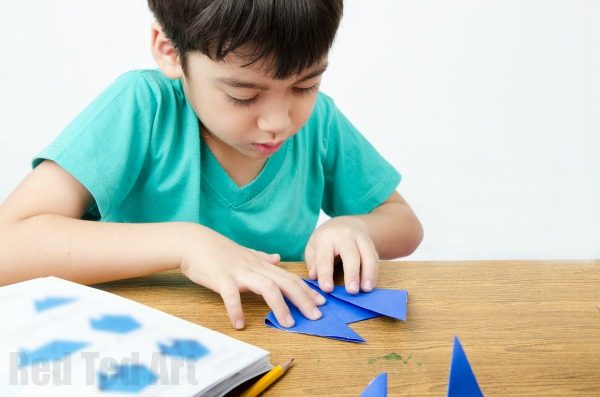
Origami is the Japanese art of paper folding in order to transform a flat square sheet of paper into a three-dimensional shape such as animals, flowers, or geometric shapes. The most exciting thing about Origami is that you have to do all of this without using scissors or glue.
Since origami involves complex folding techniques to create the shape at the end, it helps children develop fine motor skills, hand-eye coordination, and sequential thinking. In addition, engaging in origami requires focus and attention to details, which helps children improve their concentration and mental awareness.
12. Clay
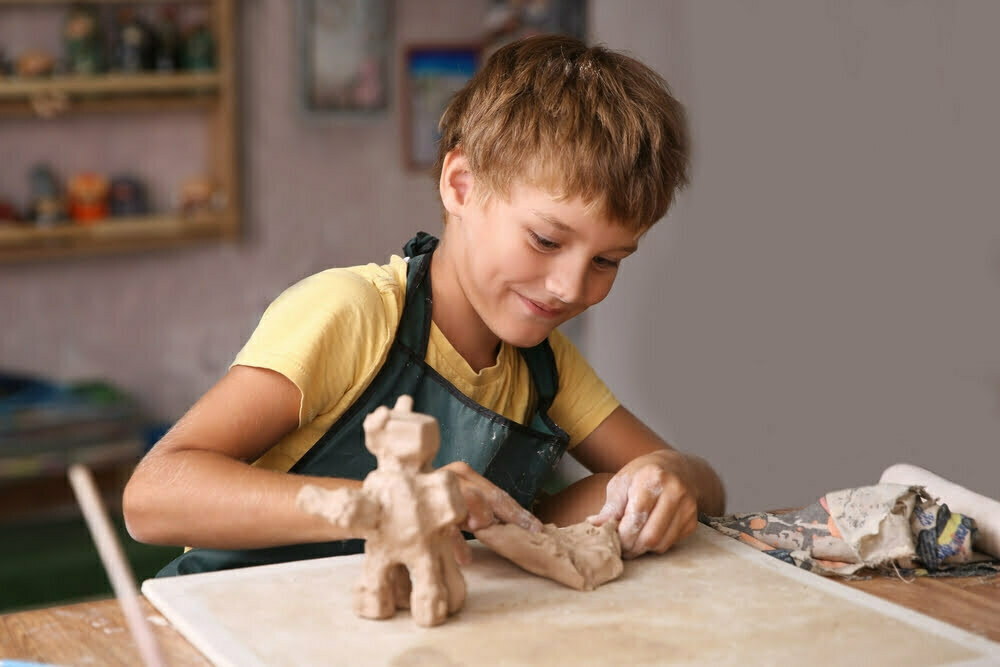
No matter how much games have evolved over time, clay remains one of the most enjoyable games for both children and adults. The enjoyment derived from working with clay stems from its versatility and boundless potential. The fun in playing with clay lies in its versatility and limitlessness. Unlike pre-made games that offer limited play options, clay enables children to express their imagination in a myriad of shapes.
From simple shapes to complex sculptures, clay greatly enhances children’s creativity. In addition, when children press and sculpt a piece of clay to form shapes, they enhance hand-eye coordination and enhance their motor skills.
13. Block Play
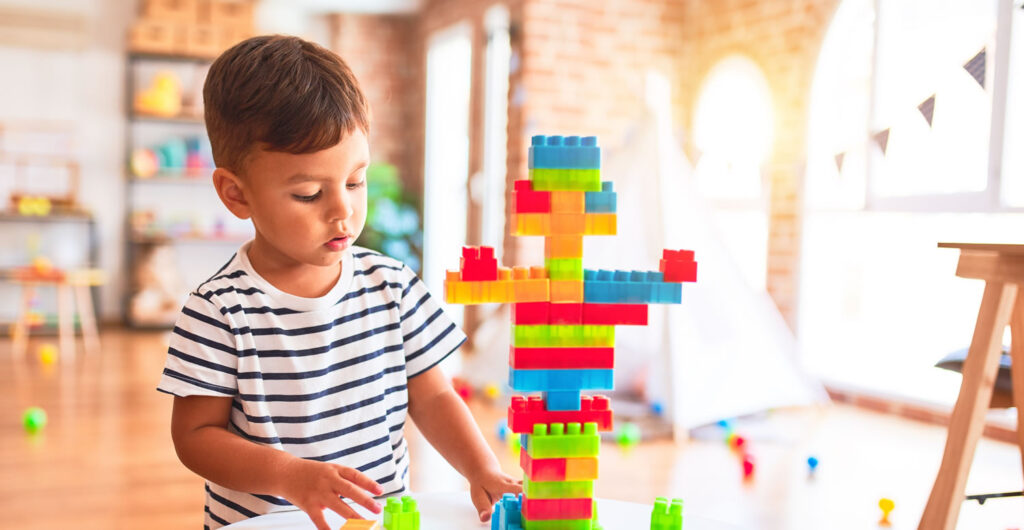
The nostalgic memories of childhood come rushing back at the mere mention of the building block play! Who hasn’t spent countless hours immersed in the world of small cubes and geometric shapes, constructing intricate structures and unleashing their creativity in a flurry of design?
Indeed, playing with building blocks transcends mere entertainment; it’s a gateway to boundless imagination and ingenuity! Whether it’s the classic wooden blocks, the versatile interlocking plastic blocks like LEGO, the foam blocks, or the magnetic blocks, the options are as diverse as the creations they inspire.
From crafting simple shapes to erecting elaborate buildings or fantastical structures, these blocks give children the freedom to explore, take apart and reassemble any building they can think of, which will take their problem-solving skills, creativity and imagination to the next level.
14. Drawing and Coloring

Drawing and coloring is one of the best recreational activities to increase a child’s creativity and enable them to express themselves and explore their artistic talents. All you have to do is provide the child with drawing materials such as paper, crayons, markers, and colored pencils, and encourage them to draw any shapes they want based on their imagination. You can also purchase a booklet that includes a number of drawings so that the child can color directly.
Finally, It’s worth mentioning that there is nothing better than holding and playing with the drawing tools to develop children’s motor skills and hand-eye coordination.
15. Dice games

At the end of our list comes the dice games such as Snakes and Ladders and Ludo, which are considered among the oldest and most famous games for different generations. So far, the article has included games to activate the body, stimulate the mind, and develop creativity, but none of them directly addressed one of the most important qualities that children must acquire, which is patience.
These games inherently require players to wait for their turn, and through this waiting, children learn how to manage their emotions and understand that their turn will come and that rushing or interrupting others is not appropriate.
As we draw the curtain on our list of best games for kids, it’s evident they’re more than just playthings; they’re gateways to a world of learning, growth, and joy within the comfort of home. From fostering creativity and critical thinking to promoting physical activity, these toys offer a myriad of benefits that shape young minds and bodies.
Now it’s your turn to embark on this adventure with your child, turning playtime into cherished moments filled with laughter and discovery. Dive into the world of these delightful toys today and witness firsthand the positive impact they have on your child’s cognitive, emotional, and physical development.
We’d love to hear from you too! Share in the comments below your favorite games and activities to enjoy with your child. And don’t forget to subscribe to our blog for a wealth of insights into effective parenting and the latest trends in education.
References: todaysparent، ourlittlejoys

